摘要:用spring-boot开发restful api非常的方便,在生产环境中,对发布的api增加授权保护是非常必要的。现在我们来看如何利用jwt技术为api增加授权保护,保证只有获得授权的用户才能够访问api。
一:开发一个简单的api
在idea开发工具中新建一个maven工程,添加对应的依赖如下:
|
1
2
3
4
5
6
7
8
9
10
11
12
13
14
15
16
17
18
19
20
21
22
23
24
25
26
27
28
29
30
31
32
33
34
35
36
37
38
39
|
<dependency> <groupid>org.springframework.boot</groupid> <artifactid>spring-boot-starter</artifactid> </dependency> <dependency> <groupid>org.springframework.boot</groupid> <artifactid>spring-boot-starter-test</artifactid> <scope>test</scope> </dependency> <dependency> <groupid>org.springframework.boot</groupid> <artifactid>spring-boot-starter-web</artifactid> </dependency> <!-- spring-data-jpa --> <dependency> <groupid>org.springframework.boot</groupid> <artifactid>spring-boot-starter-data-jpa</artifactid> </dependency> <!-- mysql --> <dependency> <groupid>mysql</groupid> <artifactid>mysql-connector-java</artifactid> <version>5.1.30</version> </dependency> <!-- spring-security 和 jwt --> <dependency> <groupid>org.springframework.boot</groupid> <artifactid>spring-boot-starter-security</artifactid> </dependency> <dependency> <groupid>io.jsonwebtoken</groupid> <artifactid>jjwt</artifactid> <version>0.7.0</version> </dependency> |
新建一个usercontroller.java文件,在里面在中增加一个hello方法:
|
1
2
3
4
5
|
@requestmapping("/hello") @responsebody public string hello(){ return "hello"; } |
这样一个简单的restful api就开发好了。
现在我们运行一下程序看看效果,执行jwtauthapplication.java类中的main方法:
等待程序启动完成后,可以简单的通过curl工具进行api的调用,如下图:
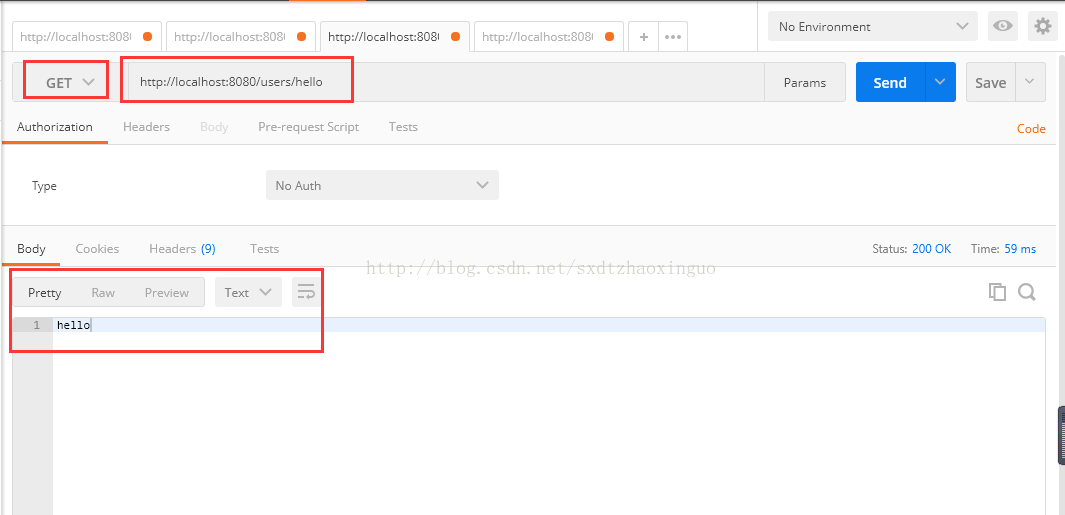
至此,我们的接口就开发完成了。但是这个接口没有任何授权防护,任何人都可以访问,这样是不安全的,下面我们开始加入授权机制。
二:增加用户注册功能
首先增加一个实体类user.java:
|
1
2
3
4
5
6
7
8
9
10
11
12
13
14
15
16
17
18
19
20
21
22
23
24
25
26
27
28
29
30
31
32
33
34
35
36
37
|
package boss.portal.entity; import javax.persistence.*; /** * @author zhaoxinguo on 2017/9/13. */@entity@table(name = "tb_user")public class user { @id @generatedvalue private long id; private string username; private string password; public long getid() { return id; } public string getusername() { return username; } public void setusername(string username) { this.username = username; } public string getpassword() { return password; } public void setpassword(string password) { this.password = password; }} |
然后增加一个repository类userrepository,可以读取和保存用户信息:
|
1
2
3
4
5
6
7
8
9
10
11
12
13
|
package boss.portal.repository; import boss.portal.entity.user;import org.springframework.data.jpa.repository.jparepository; /** * @author zhaoxinguo on 2017/9/13. */public interface userrepository extends jparepository<user, long> { user findbyusername(string username); } |
在usercontroller类中增加注册方法,实现用户注册的接口:
|
1
2
3
4
5
6
7
8
9
|
/** * 该方法是注册用户的方法,默认放开访问控制 * @param user */ @postmapping("/signup") public void signup(@requestbody user user) { user.setpassword(bcryptpasswordencoder.encode(user.getpassword())); applicationuserrepository.save(user); } |
其中的@postmapping("/signup")
这个方法定义了用户注册接口,并且指定了url地址是/users/signup。由于类上加了注解 @requestmapping(“/users”),类中的所有方法的url地址都会有/users前缀,所以在方法上只需指定/signup子路径即可。
密码采用了bcryptpasswordencoder进行加密,我们在application中增加bcryptpasswordencoder实例的定义。
|
1
2
3
4
5
6
7
8
9
10
11
12
13
14
15
16
17
18
19
|
package boss.portal; import org.springframework.boot.springapplication;import org.springframework.boot.autoconfigure.springbootapplication;import org.springframework.context.annotation.bean;import org.springframework.security.crypto.bcrypt.bcryptpasswordencoder; @springbootapplicationpublic class jwtauthapplication { @bean public bcryptpasswordencoder bcryptpasswordencoder() { return new bcryptpasswordencoder(); } public static void main(string[] args) { springapplication.run(jwtauthapplication.class, args); }} |
三:增加jwt认证功能
用户填入用户名密码后,与数据库里存储的用户信息进行比对,如果通过,则认证成功。传统的方法是在认证通过后,创建sesstion,并给客户端返回cookie。现在我们采用jwt来处理用户名密码的认证。区别在于,认证通过后,服务器生成一个token,将token返回给客户端,客户端以后的所有请求都需要在http头中指定该token。服务器接收的请求后,会对token的合法性进行验证。验证的内容包括:
- 内容是一个正确的jwt格式
- 检查签名
- 检查claims
- 检查权限
处理登录
创建一个类jwtloginfilter,核心功能是在验证用户名密码正确后,生成一个token,并将token返回给客户端:
|
1
2
3
4
5
6
7
8
9
10
11
12
13
14
15
16
17
18
19
20
21
22
23
24
25
26
27
28
29
30
31
32
33
34
35
36
37
38
39
40
41
42
43
44
45
46
47
48
49
50
51
52
53
54
55
56
57
58
59
60
61
62
63
64
65
66
67
68
|
package boss.portal.web.filter;import boss.portal.entity.user;import com.fasterxml.jackson.databind.objectmapper;import io.jsonwebtoken.jwts;import io.jsonwebtoken.signaturealgorithm;import org.springframework.security.authentication.authenticationmanager;import org.springframework.security.authentication.usernamepasswordauthenticationtoken;import org.springframework.security.core.authentication;import org.springframework.security.core.authenticationexception;import org.springframework.security.web.authentication.usernamepasswordauthenticationfilter; import javax.servlet.filterchain;import javax.servlet.servletexception;import javax.servlet.http.httpservletrequest;import javax.servlet.http.httpservletresponse;import java.io.ioexception;import java.util.arraylist;import java.util.date; /** * 验证用户名密码正确后,生成一个token,并将token返回给客户端 * 该类继承自usernamepasswordauthenticationfilter,重写了其中的2个方法 * attemptauthentication :接收并解析用户凭证。 * successfulauthentication :用户成功登录后,这个方法会被调用,我们在这个方法里生成token。 * @author zhaoxinguo on 2017/9/12. */public class jwtloginfilter extends usernamepasswordauthenticationfilter { private authenticationmanager authenticationmanager; public jwtloginfilter(authenticationmanager authenticationmanager) { this.authenticationmanager = authenticationmanager; } // 接收并解析用户凭证 @override public authentication attemptauthentication(httpservletrequest req, httpservletresponse res) throws authenticationexception { try { user user = new objectmapper() .readvalue(req.getinputstream(), user.class); return authenticationmanager.authenticate( new usernamepasswordauthenticationtoken( user.getusername(), user.getpassword(), new arraylist<>()) ); } catch (ioexception e) { throw new runtimeexception(e); } } // 用户成功登录后,这个方法会被调用,我们在这个方法里生成token @override protected void successfulauthentication(httpservletrequest req, httpservletresponse res, filterchain chain, authentication auth) throws ioexception, servletexception { string token = jwts.builder() .setsubject(((org.springframework.security.core.userdetails.user) auth.getprincipal()).getusername()) .setexpiration(new date(system.currenttimemillis() + 60 * 60 * 24 * 1000)) .signwith(signaturealgorithm.hs512, "myjwtsecret") .compact(); res.addheader("authorization", "bearer " + token); } } |
该类继承自usernamepasswordauthenticationfilter,重写了其中的2个方法:
attemptauthentication :接收并解析用户凭证。
successfulauthentication :用户成功登录后,这个方法会被调用,我们在这个方法里生成token。
授权验证
用户一旦登录成功后,会拿到token,后续的请求都会带着这个token,服务端会验证token的合法性。
创建jwtauthenticationfilter类,我们在这个类中实现token的校验功能。
|
1
2
3
4
5
6
7
8
9
10
11
12
13
14
15
16
17
18
19
20
21
22
23
24
25
26
27
28
29
30
31
32
33
34
35
36
37
38
39
40
41
42
43
44
45
46
47
48
49
50
51
52
53
54
55
56
57
58
59
60
61
|
package boss.portal.web.filter;import io.jsonwebtoken.jwts;import org.springframework.security.authentication.authenticationmanager;import org.springframework.security.authentication.usernamepasswordauthenticationtoken;import org.springframework.security.core.context.securitycontextholder;import org.springframework.security.web.authentication.www.basicauthenticationfilter; import javax.servlet.filterchain;import javax.servlet.servletexception;import javax.servlet.http.httpservletrequest;import javax.servlet.http.httpservletresponse;import java.io.ioexception;import java.util.arraylist; /** * token的校验 * 该类继承自basicauthenticationfilter,在dofilterinternal方法中, * 从http头的authorization 项读取token数据,然后用jwts包提供的方法校验token的合法性。 * 如果校验通过,就认为这是一个取得授权的合法请求 * @author zhaoxinguo on 2017/9/13. */public class jwtauthenticationfilter extends basicauthenticationfilter { public jwtauthenticationfilter(authenticationmanager authenticationmanager) { super(authenticationmanager); } @override protected void dofilterinternal(httpservletrequest request, httpservletresponse response, filterchain chain) throws ioexception, servletexception { string header = request.getheader("authorization"); if (header == null || !header.startswith("bearer ")) { chain.dofilter(request, response); return; } usernamepasswordauthenticationtoken authentication = getauthentication(request); securitycontextholder.getcontext().setauthentication(authentication); chain.dofilter(request, response); } private usernamepasswordauthenticationtoken getauthentication(httpservletrequest request) { string token = request.getheader("authorization"); if (token != null) { // parse the token. string user = jwts.parser() .setsigningkey("myjwtsecret") .parseclaimsjws(token.replace("bearer ", "")) .getbody() .getsubject(); if (user != null) { return new usernamepasswordauthenticationtoken(user, null, new arraylist<>()); } return null; } return null; } } |
该类继承自basicauthenticationfilter,在dofilterinternal方法中,从http头的authorization 项读取token数据,然后用jwts包提供的方法校验token的合法性。如果校验通过,就认为这是一个取得授权的合法请求。
springsecurity配置
通过springsecurity的配置,将上面的方法组合在一起。
|
1
2
3
4
5
6
7
8
9
10
11
12
13
14
15
16
17
18
19
20
21
22
23
24
25
26
27
28
29
30
31
32
33
34
35
36
37
38
39
40
41
42
43
44
45
46
47
|
package boss.portal.security;import boss.portal.web.filter.jwtloginfilter;import boss.portal.web.filter.jwtauthenticationfilter;import org.springframework.boot.autoconfigure.security.securityproperties;import org.springframework.context.annotation.configuration;import org.springframework.core.annotation.order;import org.springframework.http.httpmethod;import org.springframework.security.config.annotation.authentication.builders.authenticationmanagerbuilder;import org.springframework.security.config.annotation.web.builders.httpsecurity;import org.springframework.security.config.annotation.web.configuration.websecurityconfigureradapter;import org.springframework.security.core.userdetails.userdetailsservice;import org.springframework.security.crypto.bcrypt.bcryptpasswordencoder; /** * springsecurity的配置 * 通过springsecurity的配置,将jwtloginfilter,jwtauthenticationfilter组合在一起 * @author zhaoxinguo on 2017/9/13. */@configuration@order(securityproperties.access_override_order)public class websecurityconfig extends websecurityconfigureradapter { private userdetailsservice userdetailsservice; private bcryptpasswordencoder bcryptpasswordencoder; public websecurityconfig(userdetailsservice userdetailsservice, bcryptpasswordencoder bcryptpasswordencoder) { this.userdetailsservice = userdetailsservice; this.bcryptpasswordencoder = bcryptpasswordencoder; } @override protected void configure(httpsecurity http) throws exception { http.cors().and().csrf().disable().authorizerequests() .antmatchers(httpmethod.post, "/users/signup").permitall() .anyrequest().authenticated() .and() .addfilter(new jwtloginfilter(authenticationmanager())) .addfilter(new jwtauthenticationfilter(authenticationmanager())); } @override public void configure(authenticationmanagerbuilder auth) throws exception { auth.userdetailsservice(userdetailsservice).passwordencoder(bcryptpasswordencoder); } } |
这是标准的springsecurity配置内容,就不在详细说明。注意其中的
|
1
2
|
.addfilter(new jwtloginfilter(authenticationmanager())) .addfilter(new jwtauthenticationfilter(authenticationmanager())) |
这两行,将我们定义的jwt方法加入springsecurity的处理流程中。
下面对我们的程序进行简单的验证:
# 请求hello接口,会收到403错误,如下图:
curl http://localhost:8080/hello
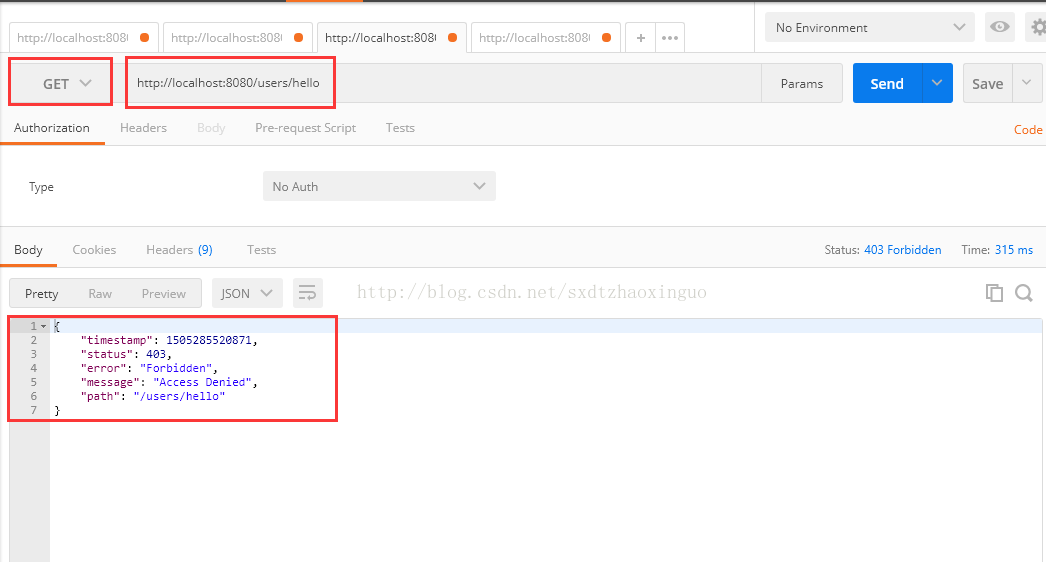
# 注册一个新用户curl -h"content-type: application/json" -x post -d '{"username":"admin","password":"password"}' http://localhost:8080/users/signup
如下图:
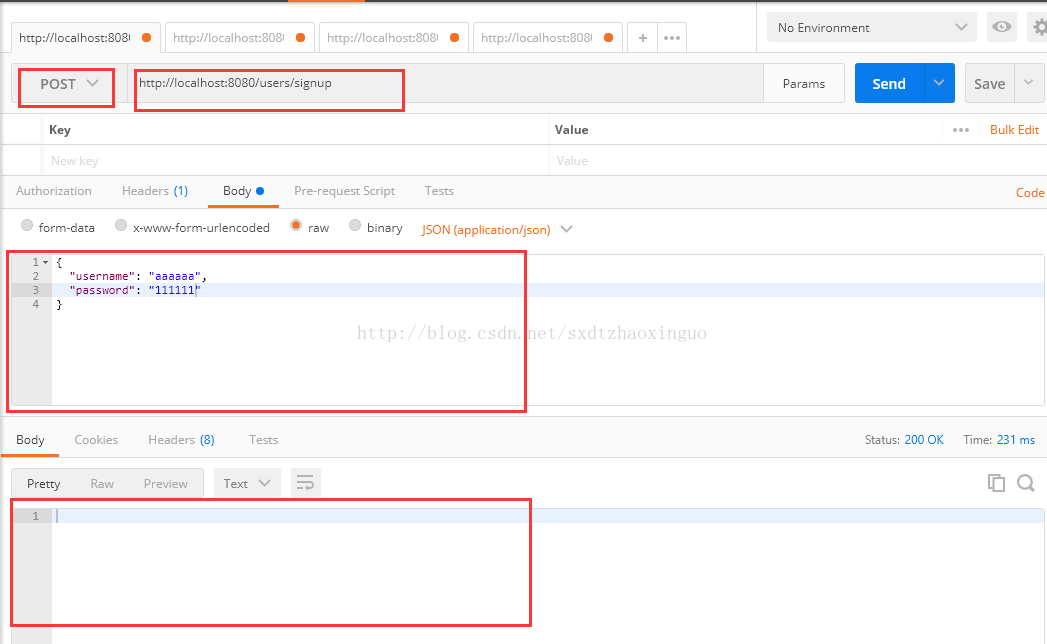
# 登录,会返回token,在http header中,authorization: bearer 后面的部分就是tokencurl -i -h"content-type: application/json" -x post -d '{"username":"admin","password":"password"}' http://localhost:8080/login
如下图:
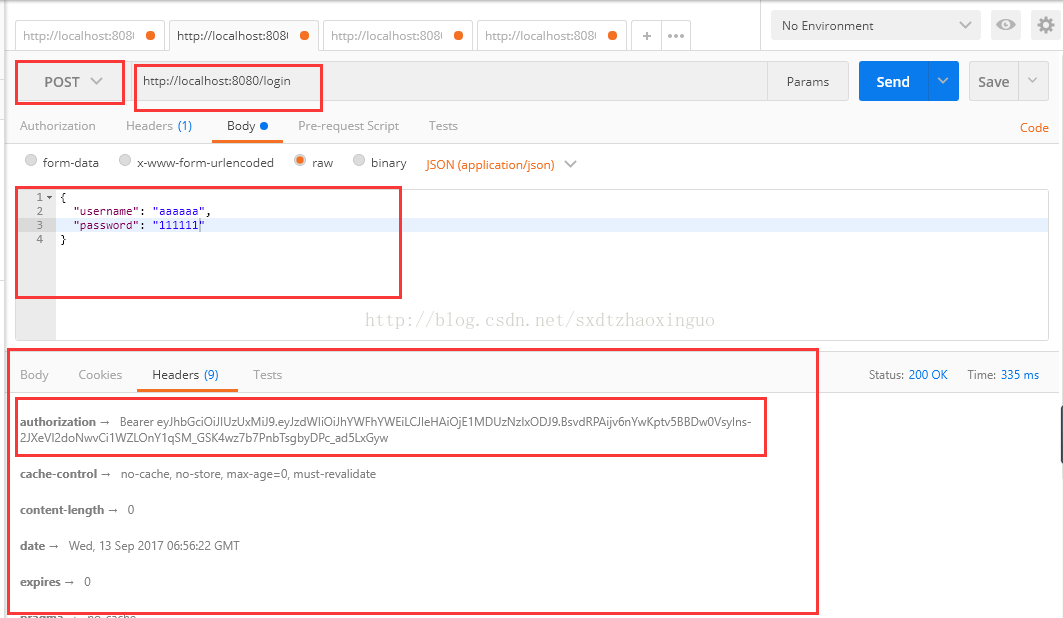
# 用登录成功后拿到的token再次请求hello接口# 将请求中的xxxxxx替换成拿到的token# 这次可以成功调用接口了curl -h"content-type: application/json" \-h"authorization: bearer xxxxxx" \"http://localhost:8080/users/hello"
如下图:
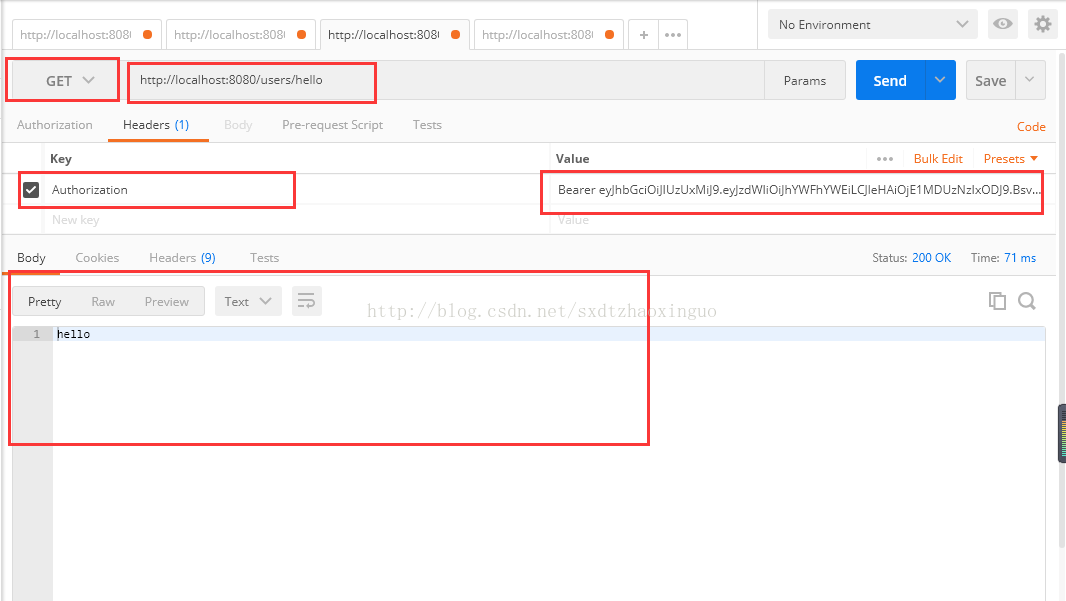
五:总结
至此,给springboot的接口加上jwt认证的功能就实现了,过程并不复杂,主要是开发两个springsecurity的filter,来生成和校验jwt token。
jwt作为一个无状态的授权校验技术,非常适合于分布式系统架构,因为服务端不需要保存用户状态,因此就无需采用redis等技术,在各个服务节点之间共享session数据。
六:源码下载地址
地址:https://gitee.com/micai/springboot-springsecurity-jwt-demo
以上就是本文的全部内容,希望对大家的学习有所帮助,也希望大家多多支持服务器之家。
原文链接:https://blog.csdn.net/sxdtzhaoxinguo/article/details/77965226
















